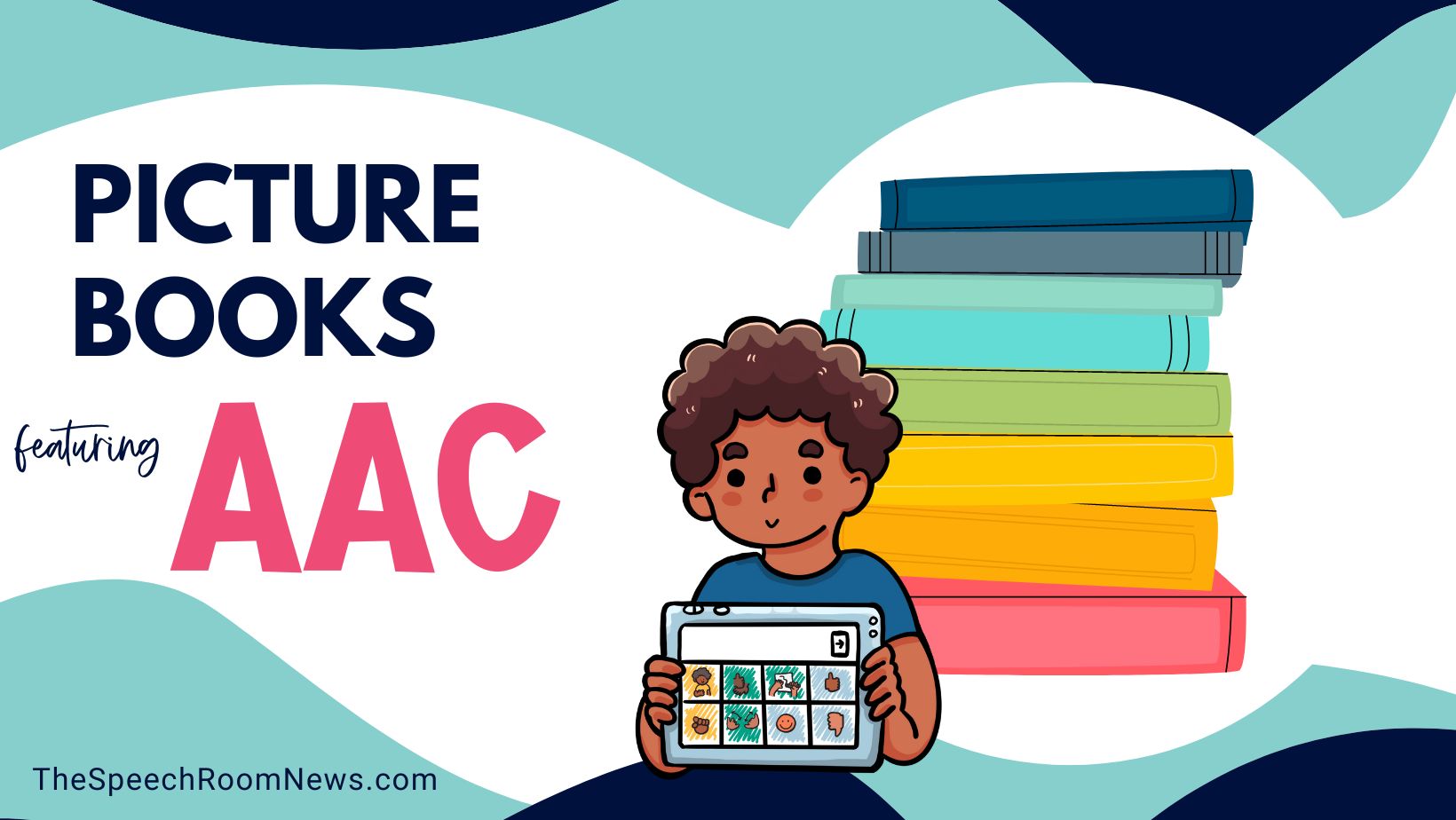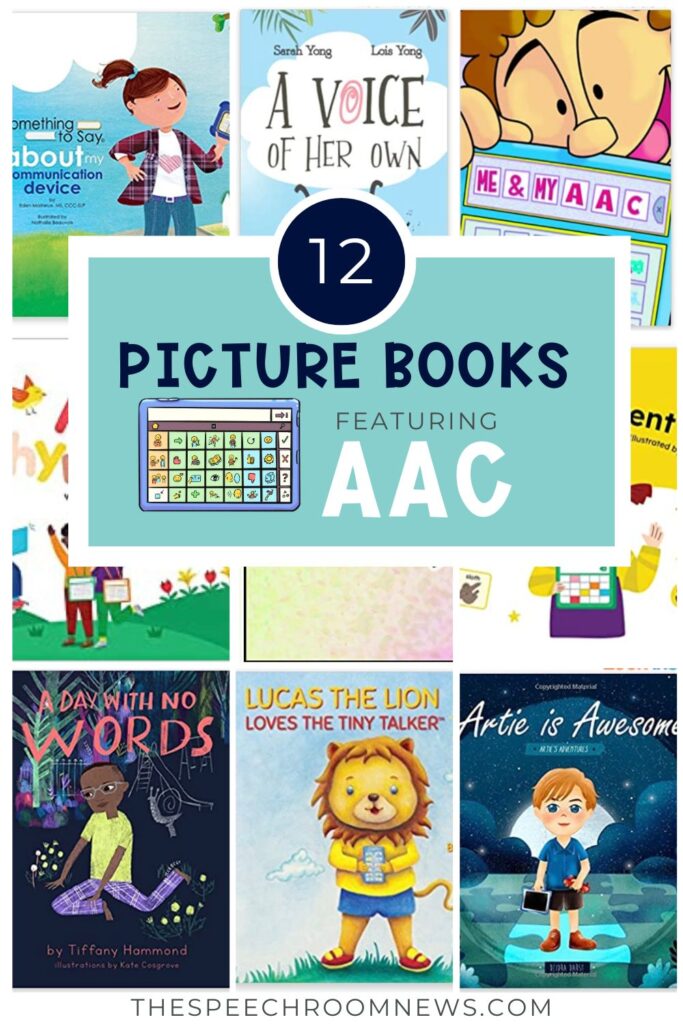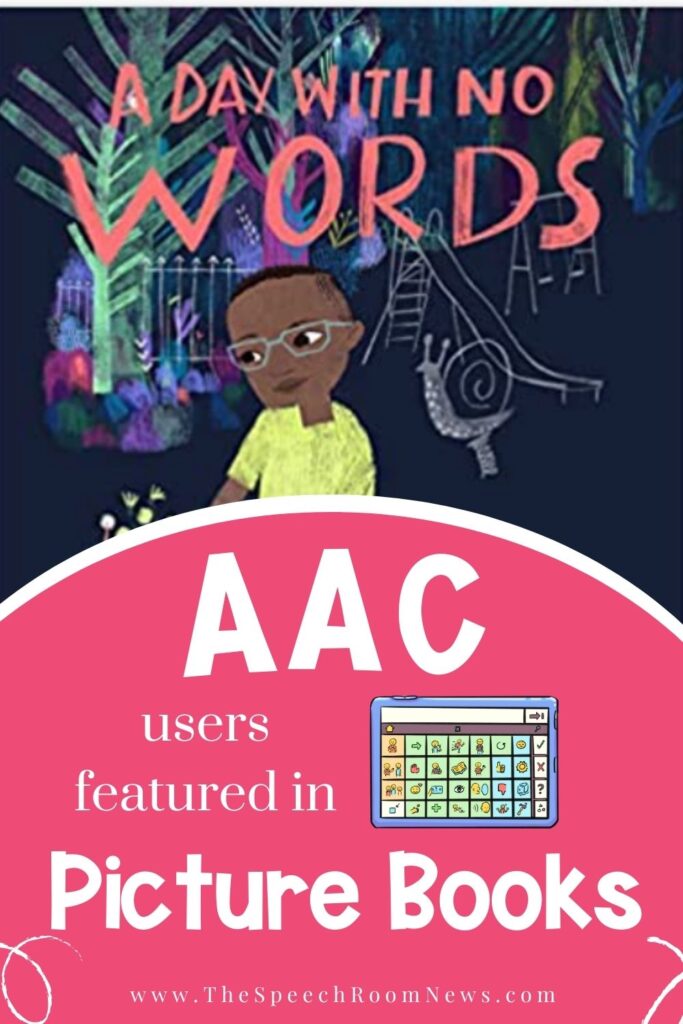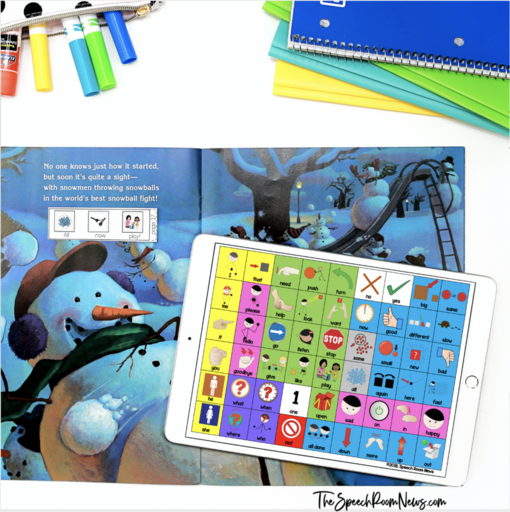Books that feature AAC Users are pretty rare but especially important in the field of speech-language pathologists. Like any obsessed book-lover, I got a new book in the mail that I pre-ordered last week and it inspired me to make a new book list! Here are some books that feature AAC (Augmentative and Alternative Communication) users and devices!
Why are picture books that feature AAC users important?
We have to consider that our students read book after book demonstrating children who can verbally speak. Never seeing themselves in a book character unless we actively look for books that feature AAC users.
Dr. Rudine Sims Bishop, author of “Mirrors, Windows, and Sliding Glass Doors” asserts:
“Books are sometimes windows, offering views of worlds that may be real or imagined, familiar or strange. These windows are also sliding glass doors, and readers have only to walk through in imagination to become part of whatever world has been created or recreated by the author. When lighting conditions are just right, however, a window can also be a mirror. Literature transforms human experience and reflects it back to us, and in that reflection we can see our own lives and experiences as part of a larger human experience. Reading, then, becomes a means of self-affirmation, and readers often seek their mirrors in books.” Full link here.
It’s critical to provide that “mirror” for them!
Who should read books that feature AAC users?
Everyone! If we want to normalize the use of alternative communication forms, we need to include those experiences in every day activities for all children. Picture books are a great way introduce these alternative forms of communication (sign language, core boards, tablets, devices, etc.)used by people with communication disabilities to all children. When they encounter a person with a communication disability in daily life, they will have had previous exposure to the tools.
Quick list here and more details listed below about each book. This website uses affiliate links for your convenience. Purchasing through an affiliate link doesn’t cost you anything and provides a small compensation to this page for the free resources.
Picture Books that feature AAC devices and AAC users
- “A Day with No Words “ by Tiffany Hammond
- “Something to Say” by Eden Molineux (Author), Nathalie Beauvois (Illustrator)
- AAC Rhyme timeby Amanda C Hartmann (Author), Nanhee Ha (Illustrator)
- Me and My AAC (Spectacular Spectrum Book Series) by Tabitha Cabrera (Author), Michael Barnett (Illustrator)
- Lucas the Lion Loves The Tiny Talker
- Eddie the Elephant Has Something to Say by Allison Johns
- Artie is Awesome by by Deidra Darst
- A Voice of Her Ownby Lois Yong (Author), Sarah Yong (Author)
- Do You Talk the Way I Talk? by Tabitha Cabrera (Author), Michael Barnett (Illustrator)
- All About Core: An Alphabet Book for Emerging Readers by Rebecca Eisenberg (Author), Harry Pixel (Illustrator)
- How Katie Got a Voice (and a cool new nickname) by Patricia Mervine
- I Talk in Different Ways by Amanda C Hartmann (Author), Nanhee Ha (Illustrator)
AAC Book Details
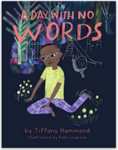
“A Day with No Words “ by Tiffany Hammond (A NYT #1 BestSeller)
The American Library Association Booklist starred review boasts, “The story is written from the boy’s first-person perspective, however—a clever choice in that it gives readers a direct look into his mind and reinforces the book’s crucial statement that nonverbal people have as many words and as much intelligence as anyone else. Cosgrove’s art, throughout, does an amazing job of transporting readers into his perspective, employing various color tones, metaphoric imagery, and ‘camera’ angles to reflect the deep expressiveness contained in every page […] through this book, neurotypicals’ eyes will be opened, and everyone in Autistic Families will feel seen—and heard.”
A Day With No Words is a colorful and engaging picture book for young readers shares what life can look like for families who use nonverbal communication, utilizing tools to embrace their unique method of “speaking.”
The story highlights the bond between mother and child and follows them on a day where they use a tablet to communicate with others.
Written by an autistic mother of two autistic sons and the creator behind the popular @Fidgets.and.Fries social media platform and illustrated by Kate Cosgrove (IG @k8cosgrove), A Day With No Words successfully normalizes communication methods outside of verbal speech and provides representation of neurodiversity and autism in a way that affirms and celebrates.
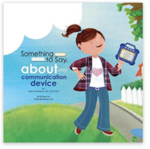
“Something to Say” by Eden Molineux (Author), Nathalie Beauvois (Illustrator)
Kate is friendly and loves to laugh. She’s also a little competitive. Kate explains how she uses a communication device to help her express herself.
The Something to Say Collection promotes self-advocacy, understanding of speech and language differences, and conversation about embracing diversity. Written by a speech-language pathologist, each book features a character with a communication difference. Characters’ strengths and interests are highlighted, while the reader gains an increased understanding of how to support communication. Readers can feel a connection to the characters as they reflect on their own experiences and enjoy the sweet and colorful illustrations.
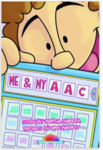
Me and My AAC (Spectacular Spectrum Book Series) by Tabitha Cabrera (Author), Michael Barnett (Illustrator)
Join Ben as he shows you his very special way of communicating. It is different but we think different is good. He uses his AAC to talk to his friends and family. He will take you on an adventure to see and feel the magic he finds in trains. Ben is so glad he has a unique way to communicate with the world and that he can share it with you. The story told from his voice, his AAC.
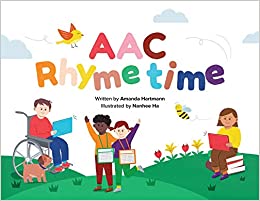
AAC Rhyme timeby Amanda C Hartmann (Author), Nanhee Ha (Illustrator)
AAC for me?
Discover rhyming words in this fun book.
And explore all the different ways we can play with rhyme in this special book that includes children who use AAC.
What is AAC? AAC stands for Augmentative and Alternative Communication. It sounds complicated but it is not. Some children cannot always speak, so they use AAC. AAC can be communicating with pictures or gestures or typing.
This book has been written to help our community learn more about differences, in particular, differences in communication. Children who use AAC may communicate differently but they still have stories and ideas to share with the world.
Amanda Hartmann, the author of AAC Rhyme time, has been Speech-Language Pathologist and an AAC enthusiast for over 20 years. She has helped many children who use AAC and the people that support them. She is passionate about connecting with and advocating for people who use AAC.
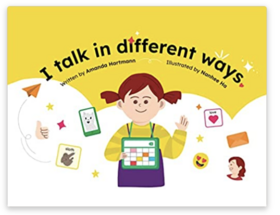
I Talk in Different Ways by Amanda C Hartmann (Author), Nanhee Ha (Illustrator)
wave, I smile, I point… I talk! And I have so many things to say!
Explore how a young AAC user communicates and connects with the people in her life. She talks to them in so many different ways.
What is AAC? AAC stands for Augmentative and Alternative Communication. It sounds complicated but it’s not. Some children cannot always speak, so they use AAC. AAC can be communicating with pictures or gestures or typing. Children who use AAC may communicate differently, but like everyone else, have stories and ideas to share with the world.
Amanda Hartmann, the author of AAC Rhyme Time and I talk in different ways, has been a Speech-Language Pathologist and an AAC enthusiast for 25 years. She has helped many children who use AAC and the people that support them. She is passionate about connecting with and advocating for people who use AAC.
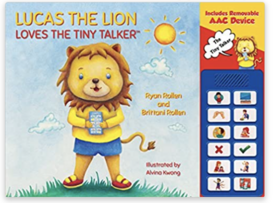
Lucas the Lion Loves The Tiny Talker
Lucas the lion cub loves playing with his friends, snacking on his favorite foods and watching his favorite shows on TV just like everyone else. But unfortunately, Lucas can’t talk. This makes communicating difficult for Lucas, and frustrating, because people don’t understand what he wants and he can’t find a way to tell them. Then one day, Lucas’ mom brings home The Tiny Talker™ to help when he can’t find the words he needs. The Tiny Talker Method helps children with communicative disabilites learn to use an augmentative and alternative communication (AAC) device in a more natural way. By pairing the device with a storybook, children are able to see the symbols in the story, touch the corresponding sound buttons on their Tiny Talker device, and hear the device’s response. This reinforces children’s understanding by appealing to visual, kinesthetic, and auditory learning styles all at once. Lucas the Lion Loves The Tiny Talker is a fun and intuitive way to help children find their voice!

How Katie Got a Voice (and a cool new nickname) by Patricia Mervine
“How Katie Got a Voice (and a cool new nickname)” is a story of challenge, triumph, and acceptance. The students and teachers of Cherry Street School all have nicknames that celebrate their differences. But the new girl, Katie, is really different. She can’t walk. She can’t talk. It seems like she can’t do anything! So how can the other students involve her in their activities? And how can they give her a nickname?
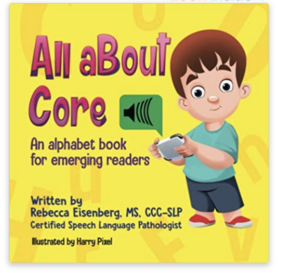
All About Core: An Alphabet Book for Emerging Readers by Rebecca Eisenberg (Author), Harry Pixel (Illustrator)
This alphabet book was created by a certified speech and language pathologist for emerging readers who use augmentative and alternative communication systems (AAC). All aBout Core (ABC) Alphabet book isn’t your typical ABC book which highlights mostly nouns. This unique ABC book incorporates core and fringe vocabulary to help improve literacy and communication for emerging readers with complex communication needs. The targeted words with sentences target functional communication and vocabulary that are ideal for all ages and abilities. The engaging and concrete illustrations focus specifically on high frequency core words that are used most often in conversation to increase carryover from activity to conversation. This book is created specifically to be used in a variety of settings including home and classroom environments. Goals targeting communication, literacy and language work seamlessly with this highly unique book.

Do You Talk the Way I Talk? by Tabitha Cabrera (Author), Michael Barnett (Illustrator)
Tyler would like to introduce you to his favorite friends. They all like a lot of the same things but they communicate in different ways. Together Tyler, Inez, Bea, and Ben celebrate both their similarities and their differences. They’ve built their friendship through communication, and sometimes it’s unspoken. How do you talk?
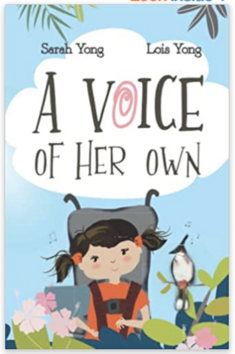
A Voice of Her Ownby Lois Yong (Author), Sarah Yong (Author)
A must-read for children with complex communication needs but also for all of us who need a little inspiration and courage to find our own voices.
Mei is a smart and imaginative ten-year-old with Cerebral Palsy who longs to connect with people around her. Unable to express herself clearly, Mei feels unheard and alone, caged up like her pet bird Kakoo. Mei and Kakoo’s stories intertwine as they discover friendship, freedom and their place in the world.
Sarah and Lois Yong masterfully welcome us into Mei’s mind through a delightful use of colors as the embodiment of voices. Vignettes of Mei’s daily life give us a glimpse of what it’s like to express yourself through Augmentative and Alternative Communication (AAC). Set in the island-city of Singapore, local references and thoughtful details invite us into Mei and Kakoo’s world as they discover the power of words to bring freedom and connectivity.
Small but mighty! This little book contains a powerful story that extends beyond its pages.
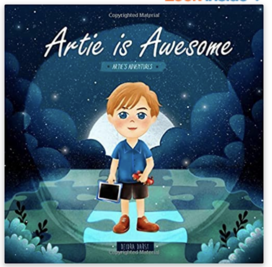
Artie is Awesome by by Deidra Darst
“Every child is special, I tell you that’s true…” Meet our awesome friend Artie: he loves trains, playing chase, and eating pizza. Artie also has autism. Let’s appreciate the differences that make each one of us special (and also make us really, really cool).
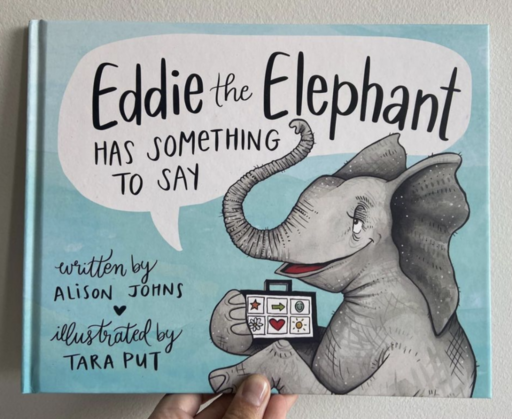
Eddie the Elephant Has Something to Say by Allison Johns
Eddie has lots of ideas… but it is so frustrating when his friends don’t understand him! So he comes up with the brilliant idea to create an augmentative and alternative communication device to help him communicate his ideas more clearly.
Augmentative and alternative communication (AAC) is any mode of communication used to supplement or replace speech, and is used by individuals who have disabilities that impact their speech.
Eddie the Elephant has Something to Say is a beautifully illustrated children’s story that aims to help children and adults learn more about augmentative and alternative communication (AAC). Eddie’s story teaches about different ways of communicating, and about the importance of being able to express yourself and be understood. It is written and illustrated by Speech-Language Pathologists Alison Johns and Tara Put, and includes a foreword by AAC communicator Chelsea Hagen.
We believe that this project will be extremely valuable not only to help educate the public about AAC, but also to allow children and families who use AAC to see themselves represented in the books that they read.
If your students are AAC users who love picture books, have you used their symbols in books yet? It’s a simple and effective way to engage early AAC users in success!
I have created pre-made core word adapted AAC picture book companions. You can swap any AAC symbol your student is using into the downloads using Adobe Reader as long as you have a jpg of the symbols! Check out the winter set, spring set or fall set of AAC Core Adapted Books.
Interested in learning more about AAC? Jenna earned a certificate in Assistive Technology after her graduate program and loves sharing about AAC. You can read about Implementation, Free Apps, AAC Lending Libraries, Free Door Hangers, Giant Core Boards, Free Sounding Board App Parent Handout, Core Word of the Week Packets, Keyguards, and Aided Language Stimulation.
We would love to hear your favorite books that feature AAC! Leave a comment below.
✕
Join the SRN newsletter!

I’m so glad you stopped by! If you’d like to keep up with the newest posts and get exclusive free downloads, please sign up for the newsletter! Your first freebie is ready as soon as you subscribe and confirm your email!
